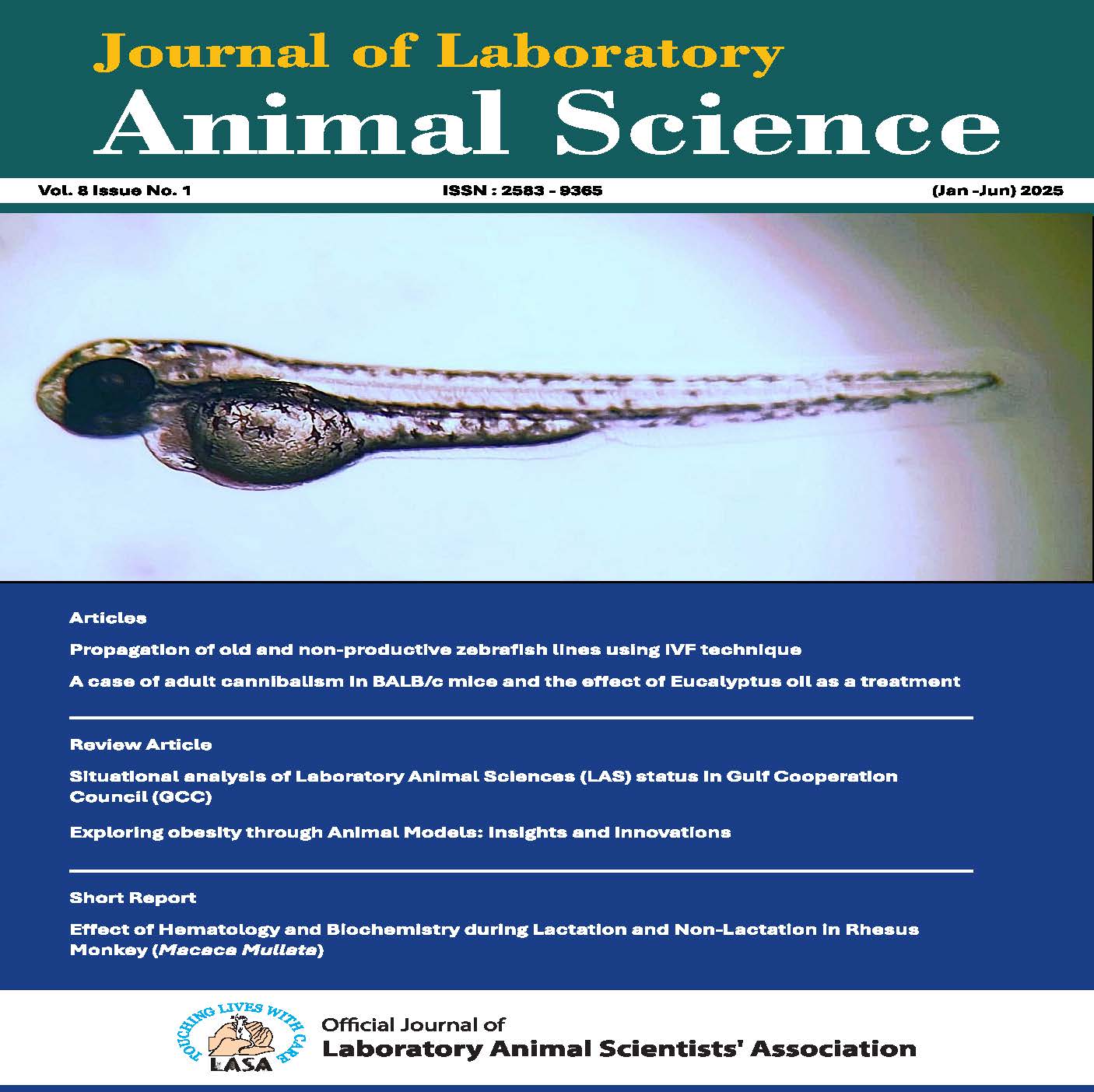Animal models for Cancer research and treatment
DOI:
https://doi.org/10.48165/jlas.2021.4.2.4Keywords:
animals and second, laboratory, animalsAbstract
Use of laboratory animals is unavoidable in cancer research throughout the world. It would have been impossible to reconstruct the events that occur in human patients with cancers without use of appropriate animal models. Based on the type of cancer research, various models ranging from normal mice/ rats, GEMM, specialised and super specialised animal models are a choice. Use of more specialised and humanized mice models is advantageous due to higher percentage of tumor acceptance and metastasis rate. However, maintenance of such animals need improved housing and environmental conditions in addition to high quality food/water and trained manpower to maintain these animals. If all these facilities are available, it is not difficult to breed/maintain quality animals for the cancer research with reproducible and meaningful results
Downloads
References
1. Isselbacher Kurt J, Barger A Clifford, Cuatrecasas Pedro, Loew Franklin M, Purpura Dominick P, Thompson Richard F (1991). Why Are Animals Used in Research? In Frank Press and Samuel O. Their (eds). Science, Medicine, and Animals, National Academic Press, Washington, pp 4-5.
2. Morton CL and Houghton PJ (2007). Establishment of human tumor xenografts in immunodeficient mice. Nature Protocols; 2: 247-250.
3. Richmond A and Su Y (2008). Mouse xenograft models vs GEM models for human cancer therapeutics. Dis Model Mech; 1 (2-3): 78-82.
4. Kerbel RS (2003). Human tumor xenograft as predictive preclinical model for anticancer drug activity in humans. Cancer Biol Ther; 2 (4-1): S 134-139.
5. Johnson JI, Decker S, Zaharevitz D et al (2003). Relationship between drug activity in NCI preclinical in vitro and in vivo model and early clinical trials. Br. J. Cancer; 9: 1424-1431.
6. Sausville EA and Burger AM (2006). Contributions of human tumor xenograft to anticancer drug development. Cancer Res; 66 (7): 3351-3354.
7. Giavazzi R, Campbell DE, Jessup JM et al (1986). Metastatic behaviour of tumor cells isolated form primary and metastatic humnan colorectal carcinomas implanted into different sites in Nude mice. Cancer Res; 46: 1929-
1933.
8. Morikawa K, Walker SM, Jessup JM et al (1988). In vivo selction of highly metastatic cells from surgical specimens of different primary human colon carcinomas implanted into Nude mice. Cancer Res; 48: 1943-1948.
9. Anderson Graham and McCarthy Nicholas I, (2015). Laying Bare the Nude Mouse Gene. J Immunol; 194:847- 848.
10. Bosma MJ, Custer RP and Caroll AM, (1983). A Severe combined immunodeficiency mutation in the mouse. Nature; 301 (5900): 527-30.
11. Fulop GM and Phillips RA, (1990). The scid mutation in mice causes a general defect in DNA repair. Nature; 347: 479- 82.
12. Dore J.F., Bailley M. and Bertrand S. Metastases of human tumors in experimental animals. Anticancer Res; 1987, 7 (5B): 997-1003.
13. Teicher BA (2006). Tumor model for efficacy determination. Mol. Cancer Ther; 5 (10): 2435-2443.
14. Tzukerman Maty, Rosenberg Tzur, Ravel Yael et al (2003). An experimental platform for studying growth and invasiveness of tumor cells within teratomas derived from human embryonic stem cells. PNAS; 100 (23): 13507-13512.
15. Pompili, L, Porru, M, Caruso, C et al (2016). Patient derived xenograft: a relevant preclinical model for drug development. J Exp Clin Cancer Res; 35,189.
16. Ingle AD and Hosetti BB (2010). Use of immuno compromised mouse model for establishment and study of human/ animal tumors. Ind J Vet Pathol; 34, 2: 156- 61.
17. Ingle AD and Hosetti BB (2012). Metastatic behavior of human tumour xenografts in immuno-compromised mouse model. Ind J Vet Pathol; 36,2: 192-197.
18. Fu X.Y, Besterman JM, Monosov A et al (1991). Models of human metastatic colon cancer in nude mice orthotopically constructed by using histologically intact patient specimens. Proc Natl Acad Sci; 88: 9345-9349.
19. Fei Xi Feng, Zhang Quan Bin, Dong Jun et al (2010). Development of clinically relevant orthotopic xenograft mouse model of metastatic lung cancer and glioblastoma through surgical tumor tissues injection with trocar. J. Expl. Clin. Cancer Res; 29: 84-91.
20. Priolo C, Agostini M, Vena N et al (2010). Establishment and genomic characterization of mouse xenografts of human primary prostate tumors. Am J Pathol; 176, 4: 1901-1913.
21. Jung Joohee, (2014). Human Tumor Xenograft Models for Preclinical Assessment of Anticancer Drug Development. Toxicol Res; 30,1: 1-5.
22. Lee YT (1985). Patterns of metastasis and natural course of breast carcinoma. Cancer Met Rev; 4: 153-172.
23. Fidler IJ (2003). The pathogenesis of cancer metastasis: the ‘seed and soil’ hypothesis revisited. Nat. Rev. Cancer; 3: 453-458.
24. Minn AJ, Kang Y, Seganova Y (2005). Distinct organ specific metastatic potential of individual breast cancer cells and primary tumors. J Clin Invest; 115, 1: 44-55.
25. Nemati F, Sastre-Garau X, Laurent C et al (2010). Establishment and Characterization of a Panel of Human Uveal Melanoma Xenografts Derived from Primary and/ or Metastatic Tumors. Clin. Cancer Res; 16 (8): 2352- 2363.
26. Wang X, Fu X, Brown PD et al (1994). Matrix mettaloproteinase inhibitor BB-94 (Batimastat) inhibits human colon tumor growth and spread in a patient-like orthotopic model in nude mice. Cancer Res; 54: 4726-
4728.
27. Tentler JJ, Tan AC, Weekes CD et al (2012). Patient derived human tumor xenografts model for cancer drug development. Nat Rev Clin Oncol; 9: 338-50.
28. Ingle AD and Hosetti BB (2013). Therapeutic response of Human Brain, Breast and Oral Cavity Tumors to Paclitaxel in NOD SCID mice. Int. J Bio-Pharma Res; 2,1: 39-44.
29. Hidalgo M, Amant F, Biankin A et al (2014). Budinská, E., Byrne, A. T., Caldas, C.,Villanueva, A., Patient Derived Xenograft Models: An Emerging Platform for Translational Cancer Research. Cancer Discovery; 4(9): 998-1013.
30. Morton J Jason, Bird Gregory, Refaeli Yosef et al (2016). Humanized Mouse Xenograft Models: Narrowing the Tumor–Microenvironment Gap. Cancer Res; 76,21: 6153-58.
31. Brehm Michael A, Shultz Leonard D, and Greiner Dale L (2010). Humanized Mouse Models to Study Human Diseases. Curr Opin Endocrinol Diabetes Obes; 17(2): 120–125.

